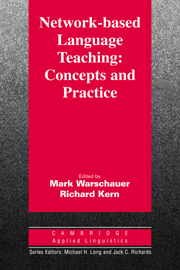Book contents
- Frontmatter
- Contents
- List of contributors
- Series editors' preface
- Preface
- 1 Introduction: Theory and practice of network-based language teaching
- 2 Sociocollaborative language learning in Bulgaria
- 3 On-line learning in second language classrooms: An ethnographic study
- 4 Negotiation in cyberspace: The role of chatting in the development of grammatical competence
- 5 Writing into change: Style shifting in asynchronous electronic discourse
- 6 Computers and collaborative writing in the foreign language curriculum
- 7 Networked multimedia environments for second language acquisition
- 8 An electronic literacy approach to network-based language teaching
- 9 Task-based language learning via audiovisual networks: The LEVERAGE project
- 10 Is networked-based learning CALL?
- Name index
- Subject index
9 - Task-based language learning via audiovisual networks: The LEVERAGE project
Published online by Cambridge University Press: 05 October 2012
- Frontmatter
- Contents
- List of contributors
- Series editors' preface
- Preface
- 1 Introduction: Theory and practice of network-based language teaching
- 2 Sociocollaborative language learning in Bulgaria
- 3 On-line learning in second language classrooms: An ethnographic study
- 4 Negotiation in cyberspace: The role of chatting in the development of grammatical competence
- 5 Writing into change: Style shifting in asynchronous electronic discourse
- 6 Computers and collaborative writing in the foreign language curriculum
- 7 Networked multimedia environments for second language acquisition
- 8 An electronic literacy approach to network-based language teaching
- 9 Task-based language learning via audiovisual networks: The LEVERAGE project
- 10 Is networked-based learning CALL?
- Name index
- Subject index
Summary
Introduction
The LEVERAGE project was part of the European Advanced Communications Technologies and Services (ACTS) program. The project's primary aim was to establish how well broadband telecommunications networks are suited to educational (and especially language learning) needs in today's multilingual and multicultural Europe. A number of partners from six European countries were involved in the project with three end-user sites in Cambridge, Madrid, and Paris. The project was built around three sets of user trials. The first trial involved nonspecialist learners of French using the network locally in Cambridge; the second trial included learners of French and English in Paris and Cambridge, respectively; and the third trial brought together learners of English, French, and Spanish from all three end-user sites. In this chapter, we report on the first and second trials.
One of the major aims of the project was to assess the practicality of providing learners of various European languages with opportunities to collaborate with their peers in the target language community via a broadband telecommunications network. Reciprocal peer tutoring was to be one of the major features of the system.
The main questions the project attempted to answer were:
How well do high-bandwidth networks support collaborative learning?
How well is a task-based approach suited to the network environment?
What facilities are required to support network-based learning?
One of the major challenges of the project was to develop an effective network-based learning methodology and to identify which factors were most important in determining its effectiveness.
Information
- Type
- Chapter
- Information
- Network-Based Language Teaching: Concepts and PracticeConcepts and Practice, pp. 186 - 203Publisher: Cambridge University PressPrint publication year: 2000
Accessibility standard: Unknown
Why this information is here
This section outlines the accessibility features of this content - including support for screen readers, full keyboard navigation and high-contrast display options. This may not be relevant for you.Accessibility Information
- 18
- Cited by
